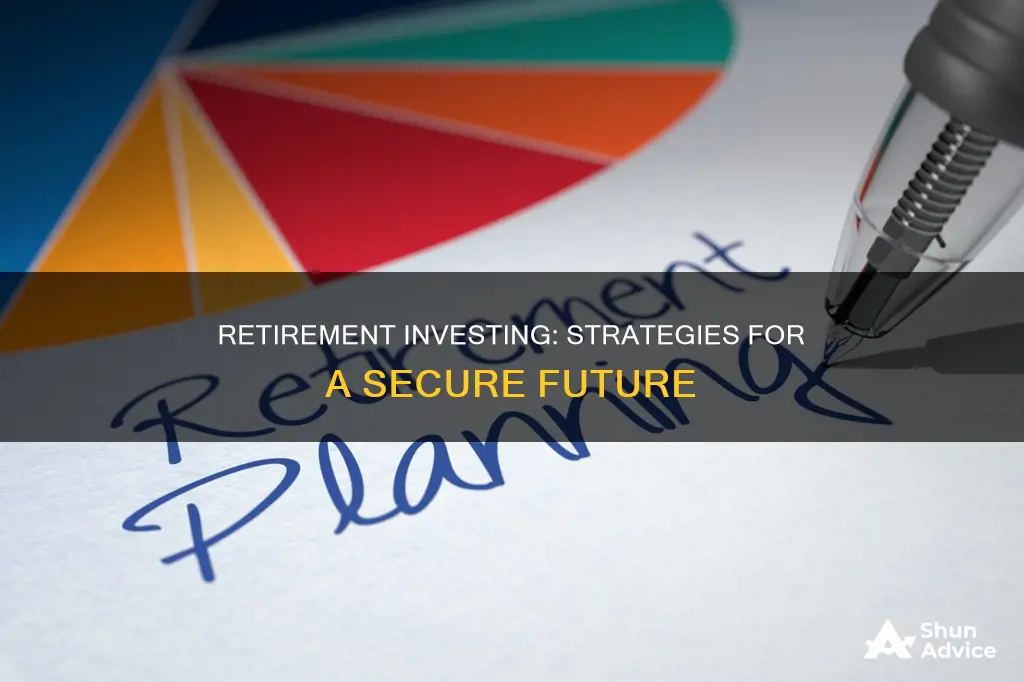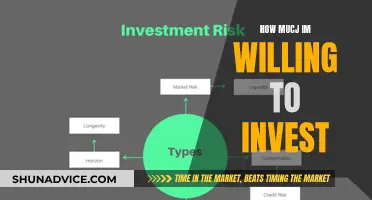
Planning for retirement can be a daunting task, but it is important to start as soon as possible. The first step is to calculate your expenses and expected income from other sources to determine how much you need to save. Then, consider the various investment options available, such as tax-advantaged accounts like 401(k)s and IRAs, dividend-paying stocks, rental properties, annuities, and more. It is recommended to have a balanced portfolio of stocks, bonds, and cash investments that aligns with your goals, time horizon, and risk tolerance. Additionally, it is crucial to protect your savings from downturns by keeping a year's worth of spending cash and two to four years' worth of living expenses in liquid accounts.
| Characteristics | Values |
|---|---|
| Investment options | Bonds, annuities, income-producing equities, stocks, dividend-paying stocks, rental property, annuities, qualified longevity annuity contracts (QLACs), mutual funds, exchange-traded funds (ETFs), robo-advisors, target-date funds, real estate investment trusts (REITs) |
| Savings accounts | 401(k)s, IRAs, pension plans, 403(b)s, 457(b)s, SEP IRAs, SIMPLE IRAs, solo 401(k)s, HSAs, 529 plans |
| Considerations | Time horizon, risk tolerance level, asset allocation, diversification, age, income, expenses, withdrawal rate, tax advantages, liquidity, growth, income |
What You'll Learn

Tax-advantaged accounts
Types of Tax-Advantaged Accounts
There are two main types of tax-advantaged accounts: tax-deferred accounts and tax-exempt accounts.
Tax-Deferred Accounts
Tax-deferred accounts allow you to save on taxes when you contribute to the account. However, you will be taxed when you withdraw money from the account. Examples of tax-deferred accounts include 401(k) plans and traditional Individual Retirement Accounts (IRAs).
Tax-Exempt Accounts
With tax-exempt accounts, you contribute after-tax dollars, but you can spend the money tax-free. Examples of tax-exempt accounts include Roth 401(k)s and Roth IRAs.
Choosing the Right Account
When deciding which type of tax-advantaged account is best for you, consider your current tax rate and your expected tax rate during retirement. If you are just starting your career and expect your salary to increase, it may make sense to pay taxes now and choose a tax-exempt account. On the other hand, if you are in your peak earning years, you may want to defer taxes until retirement when you expect to be in a lower tax bracket.
Other Considerations
In addition to tax-advantaged accounts, there are other investment options to consider for retirement, such as bonds, annuities, and income-producing equities. It is important to diversify your investments and create a balanced portfolio that aligns with your risk tolerance and investment goals.
Celebs Who Invested with Bernie Madoff
You may want to see also

Asset allocation
Time Horizon
The time until you need to use the money in your portfolio is a crucial factor in determining your asset allocation. Generally, the younger you are, the more aggressive you can be with your investments, as you have a longer time horizon and can ride out market fluctuations. As you get closer to retirement, it's typical to shift towards more conservative investments.
Goals and Investment Objective
Your investment goals and objectives play a significant role in determining your asset allocation. If you're investing for retirement, you may be focused on either income or growth. If you're primarily seeking income, you might favour investments like bonds and cash, which provide more stable and predictable returns. If growth is your main objective, you may allocate a larger portion of your portfolio to stocks, which have historically provided higher returns over the long term but come with higher risk.
Risk Tolerance
Your risk tolerance is a key consideration in asset allocation. If market volatility and fluctuations cause you stress, you may want to allocate more of your portfolio to less risky investments like bonds and cash. On the other hand, if you're comfortable with risk and market ups and downs, you may tilt your portfolio more towards stocks.
Current and Future Income Sources
Your current and future income sources will influence your asset allocation. If you're still working, you may have a higher allocation of stocks in your portfolio to maximize growth potential. In retirement, you may shift towards more conservative investments like bonds and cash to meet daily expenses and reduce risk.
Diversification
Diversifying your portfolio across different asset classes, such as stocks, bonds, and cash, is essential to managing risk. Stocks tend to be more volatile but offer higher growth potential. Bonds provide regular income and reduce risk due to their lower volatility compared to stocks. Cash and cash equivalents provide liquidity and safety but may not offer high returns.
Rebalancing
The Mortgage and Investment Balancing Act: Dave Ramsey's Take
You may want to see also

Robo-advisors or target date funds
Robo-advisors are a hybrid stock broker and investment advisor in one. They are a broad category of digital financial advisors that use sophisticated computer algorithms to create diversified investment portfolios. Many robo-advisors also offer access to human financial advisors. They are customizable, allowing retirees to rev up the aggressiveness in their portfolios or tone it down to preserve capital. They are also typically cheaper than traditional investment advisors.
Robo-advisors like SigFig will manage your investments in your existing accounts, while most will transfer your existing assets to their platform in a manner that minimizes tax liabilities. They are ideal for retirees who want to free up time to enjoy their lives instead of handling their finances or those looking to cut investment management costs by switching to a lower-cost solution.
- Empower: Offers a free retirement planner, money management tools, and a full-service investment manager for investors with $100,000 or more.
- Retirable: A recently launched platform with automated investing, portfolio management, licensed human financial advisors, and low fees.
- Betterment: One of the earliest robo-advisors, offering diverse investment styles and crypto portfolios, as well as financial advisors and cash management.
- Wealthfront: One of the original robo-advisors, offering customizable portfolios with 200 ETFs and crypto funds, as well as a cash management account for emergency funds with zero fees.
- SigFig: Manages investments in Schwab, Fidelity, and TD Ameritrade accounts, offering a free portfolio tracker and free investment management for accounts up to $10,000.
Target date funds (TDFs) are actively managed funds with a pre-determined asset allocation that automatically shifts as an investor ages. They mix several types of stocks, bonds, and other investments in a single solution to help you prepare for retirement. TDFs are great for younger investors just starting out as they offer broad diversification and an easy entry point. They are also ideal for those who want a "set it and forget it" approach, especially if their money is only in tax-advantaged accounts like a 401(k) or IRA.
TDFs are managed by professionals, who make trades based on a "glidepath" to adjust the underlying mix of investments. This helps determine the risk exposure over the course of your path through retirement by adjusting diversification levels. When you are younger, the fund takes on more investment risks, and as you get closer to retirement, it gradually becomes more conservative.
To choose a TDF, simply pick the right "target date" (the year closest to when you'd like to retire) and the fund company will automatically adjust the allocation over time.
Retirement Investments: Assessing Your Success
You may want to see also

Dividend-paying stocks
Diversification
It is important to diversify your portfolio across different industries and sectors to reduce risk. Look for companies with strong track records in a variety of sectors, such as technology, healthcare, consumer staples, and energy. This will help protect your portfolio from downturns in any one particular industry.
Consistent Dividend Payments
Look for companies with a long history of paying dividends consistently. Some companies, known as Dividend Aristocrats, have increased their dividend payouts annually for at least 25 consecutive years. These companies tend to be more stable and established, making them attractive for retirees seeking reliable income.
Dividend Yield vs. Dividend Growth
When evaluating dividend-paying stocks, consider both the current dividend yield and the potential for dividend growth. Some stocks, like Verizon, offer high dividend yields but slower dividend growth. Others, like Microsoft, may have lower current yields but stronger potential for dividend increases over time. Choose stocks that fit your income needs and investment goals.
Company Fundamentals
Analyze the fundamentals of the companies you are considering investing in. Look for companies with strong cash flow, a solid business model, and a history of innovation or strategic acquisitions. This will help ensure that they can sustain their dividend payments over the long term.
Total Return Approach
Remember that dividend-paying stocks are just one part of your retirement portfolio. Consider a total return approach, which includes both interest and capital gains, to maximize your investment returns. This will help your portfolio grow while also providing a steady income stream.
- Visa (V): A data network company with high free cash flow margins and a history of dividend growth.
- Microsoft (MSFT): A global software company with strong cash flow and a growing presence in cloud computing and AI.
- Lockheed Martin (LMT): An aeronautics and defence company with consistent free cash flow and a strong dividend growth history.
- Chevron (CVX): A large oil and gas company with significant free cash flow and a long history of annual dividend increases.
- Domino's Pizza (DPZ): The world's largest pizza company with high and consistent free cash flow margins, making it an attractive option for retirees.
Valic Retirement Investment Options: A Comprehensive Review
You may want to see also

Annuities
There are four basic types of annuities:
- Fixed vs. Variable: Fixed annuities offer a predetermined rate of return, while variable annuities base returns on the performance of a basket of stock and bond products (subaccounts). Variable annuities offer greater growth potential but also carry more risk.
- Immediate vs. Deferred: With immediate annuities, you start receiving regular payments right away, while deferred annuities are a long-term tool where you collect payments at a specified date in the future.
- Income for Life: Annuities provide income that you can't outlive, ensuring a steady income stream to supplement Social Security.
- Deferred Distributions: Annuities offer tax-deferred status, allowing you to control when you pay taxes.
- Guaranteed Rates: Fixed annuities offer a predictable rate of return, providing a stable income stream for retirees.
However, there are also some drawbacks to annuities:
- Hefty Fees: Annuities often come with high fees compared to other investment options, including upfront sales charges and annual expenses.
- Lack of Liquidity: Many annuities have surrender fees if you try to withdraw money within the first few years of the contract.
- Higher Tax Rates: Withdrawals from annuities are taxed as ordinary income, which can be higher than capital gains tax rates.
- Complexity: Annuities can be complex and hard to understand, with a variety of exotic variations available on the market.
When considering annuities for retirement, weigh the pros and cons based on your short-term and long-term goals, risk tolerance, and comfort with fees. Annuities can provide peace of mind and a secure income stream but may not be necessary if your retirement savings are already on track to last your lifetime. Additionally, consider maximizing other retirement accounts, such as a 401(k) or IRA, before investing in annuities.
Maximizing Mineral Rights Investments: A Guide
You may want to see also
Frequently asked questions
Many advisors recommend saving 10% to 15% of your income, but this can vary depending on your personal circumstances.
There are many types of investments that can help you save for retirement, including: 401(k)s, IRAs, annuities, bonds, stocks, real estate, and more.
A good investment strategy for retirement is to first take advantage of any employer match in a 401(k) or similar plan. Then, consider investing in a Roth IRA if you can. Finally, if you still have more to save, max out your 401(k).
Some common pitfalls to avoid when investing for retirement include: not saving enough, not taking advantage of tax-advantaged accounts, and not understanding the fees and risks associated with certain investments.







